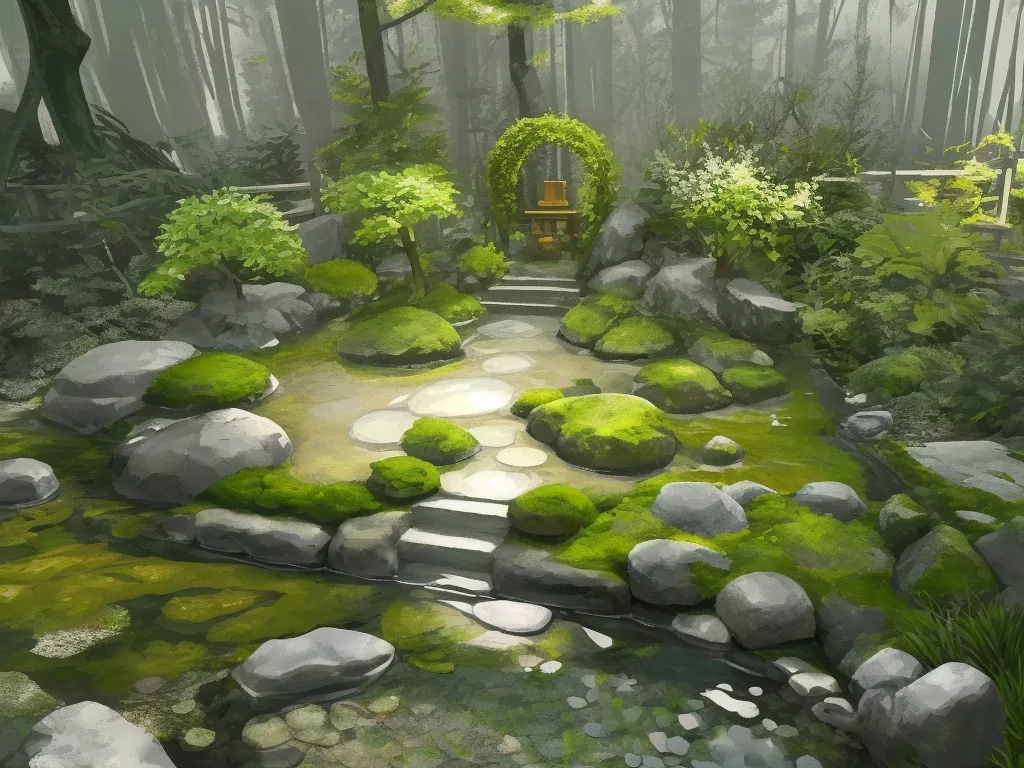Zen Gardens: Crafting a Soulful Sanctuary

Ah, Zen gardens! My forever oasis in the hustle and bustle of modern life. These masterpieces aren’t just a delightful treat for the eyes but doorways to millennia-old traditions and philosophies. And today, dear reader, we’re embarking on a journey through them. Buckle up!
Introduction
Whenever I think of a Zen garden, my mind transports me to a tranquil space, away from the constant pings of my phone and the loud honks of city traffic. There’s something about the meticulously raked sand, the stoic stones, and the occasional tuft of moss that whisper serenity. If you’ve ever felt the world moving too quickly, take a deep breath because we’re about to delve into the calming world of Zen gardens.
A Stroll Down Memory Lane: The Origins of Zen Gardens
Heian Period: Where It All Began
Zen gardens, or kare-sansui (dry landscape gardens), emerged in Japan during the Heian period (794 to 1185 AD). They were initially exclusive to the courtyards of Zen Buddhist temples. The underlying philosophy? To replicate the essence of nature, not its actual appearance. It’s like capturing the soul of a scenic landscape in a painting, minus the literal representation.
Zen Philosophy and Gardens
| Zen Principle | Description |
| Kanso | Simplicity. In the world of Zen gardens, less is more. |
| Koko | Austerity or sublime. Beauty lies in the profound, not the superficial. |
| Shizen | Naturalness. ItÂ’s all about unforced beauty; think of it as the anti-Instagram filter of the garden world. |
I don’t know about you, but every time I’ve tried my hand at minimalism (be it decluttering my room or my digital life), I’ve found it to be, paradoxically, rich and fulfilling. Zen gardens, with their austere designs and natural elements, embody this exact sentiment.
The Elemental Soul of Zen Gardens
Ah, the magical ingredients that breathe life into a Zen garden! The elements of a Zen garden are much like the colors on an artist’s palette – each has significance and contributes to the masterpiece.
1. Stones (Ishi)
The very backbone of the Zen garden!
- Arrangement: Typically, they’re grouped in odd numbers. It could be the Zen way of saying that there’s beauty in imperfection, much like my mismatched sock collection.
- Symbolism: The stones can mimic natural formations like mountains, islands, or even animals.
Here’s a fun tidbit: In some Zen gardens, a stone often remains hidden from any vantage point. This hidden stone reminds us that we can’t know or see everything, a humbling nod to life’s mysteries.
2. Sand or Gravel (Karesansui)
These are the blank canvases of Zen gardens.
- Representation: The raked patterns in the sand symbolize water. Depending on the design, they can represent everything from tranquil ponds to tumultuous oceans.
- Raking: Trust me when I say this – raking the sand is therapeutic. The repetitive motion and evolving patterns are like doodling but with a rake!
3. Plants and Moss
While not a staple in every Zen garden, when they’re present, they’re a game-changer.
- Moss: Perfect for symbolizing vast landscapes or islands amidst the ‘water.’
- Other Plants: Typically, plants that do not overshadow the design’s simplicity are chosen. Think of them as the supporting cast in a blockbuster movie; not always in the limelight, but crucial.
Alright! Let’s continue our journey into the world of Zen gardens. We’ve touched on the history and core elements. Now, let’s delve into the intricacies of designing a Zen garden, the nuances of its maintenance, and the modern twist to these soulful sanctuaries.
Designing Your Zen Space
Crafting a Zen garden is an intimate affair. It’s like painting but with nature’s colors. Here’s a roadmap for those of you keen on creating your pocket of tranquility:
1. Planning the Space
- Size Doesn’t Matter: Whether you’ve got an expansive backyard or a modest balcony, a Zen garden can fit anywhere. Remember, it’s the thought and intention that counts.
- Layout: Decide where you want the main elements. Perhaps a central stone surrounded by raked gravel? Or a mossy corner that catches the morning sun just right?
2. Choosing the Elements
Remember our star players from earlier? Stones, sand, and plants. When choosing, consider the following:
- Harmony: Look for elements that work well together. That jumbo rock might look out of place in a smaller space.
- Personal Touch: Incorporate elements that speak to you. Found a beautiful pebble on your last beach trip? It is the perfect centerpiece!
3. Crafting the Landscape
- Begin with the Heavier Elements: Place your stones first. Remember, odd groupings are a favorite in Zen designs.
- Sand Next: Pour in your gravel or sand. And then, my favorite part, rake away! Those ripples you create aren’t just patterns but reflections of your inner landscape.
- Final Touches with Flora: Add the moss, plants, or a bonsai tree. They infuse life into your Zen masterpiece.
Maintaining the Zen Magic
It’s one thing to create a Zen garden but quite another to maintain its serenity. Here’s how:
1. Regular Raking
Just like you’d water a plant, regularly rake your garden. Not only does this prevent weeds, but trust me, it’s a meditative ritual you’ll grow to cherish.
2. Moss and Plant Care
Ensure they’re not overrun by weeds or overshadowed by other dominant plants. Moss, especially, loves a bit of tender loving care!
3. Seasonal Touch-ups
Your garden will change with the seasons, and that’s the beauty of it! Adjust and adapt. Perhaps add a stone in summer, or rake a new pattern in the sand come autumn.
Modern Twists to Ancient Zen
Today’s Zen gardens are open to more than temple courtyards in Japan. They’ve traveled the world, adapting and evolving.
1. Digital Zen Gardens
With technology enveloping our lives, why not a digital detox with virtual Zen gardens? Apps now allow you to design, rake, and care for a digital Zen space. It’s like Farmville but way more calming!
2. Indoor Zen Terrariums
A transparent glass bowl, some sand, a few pebbles, and a succulent. Voila, Your personal, indoor Zen oasis. Perfect for your office desk or coffee table.
3. Community Zen Spaces
Urban spaces are now transforming into community Zen gardens. It’s where people can come, rake, meditate, or exist. Imagine, amid urban chaos, a space that reminds you to breathe.
In the profound words of Zen Master Dōgen, “If you walk in the mist, you get wet.” Zen gardens are just that – subtle yet transformative. They don’t scream for attention, but slowly, surely, they seep into your being, reminding you of the here and now.
And there, my friend is the magic of Zen gardens. They aren’t just spaces; they’re experiences. In this chaotic world, a small pocket of Zen might be the calm we all need.
Bringing Zen to Life: Practices & Rituals
While the Zen garden itself is a marvel, the rituals and practices that accompany it bring the spiritual essence to the forefront. Let’s begin understanding these time-honored traditions and how they can uplift our modern lives.
1. Tea Ceremonies
Origin: The tea ceremony, or Chanoyu, originated in Japan. Rooted in Zen principles, it emphasizes harmony, respect, purity, and tranquility.
Modern Take: Create your mini tea ritual at home. Before sipping your tea, please take a moment to appreciate its aroma, color, and taste. It’s a quick yet profound way to connect with the present.
2. Kinhin – Walking Meditation
Origin: Kinhin is the practice of walking slowly and mindfully. Every step syncs with the breath, allowing a deep communion with the Earth.
Modern Take: On your next walk, even if it’s just to the mailbox, be mindful. Feel the ground beneath, the wind around, and the sky above. It transforms a mundane task into a journey of awareness.
3. Zen Calligraphy
Origin: In Zen calligraphy, the brush, ink, and paper become an extension of the artist’s soul. Every stroke is an expression of the present moment.
Modern Take: Doodle, sketch, or play with colors. It’s not about creating a masterpiece but expressing your inner state. And trust me, it’s therapeutic!
Zen Gardens Around the World
Travel with me, albeit virtually, to some mesmerizing Zen gardens across the globe:
1. Ryōan-ji in Kyoto, Japan: Famous for its mysterious rock formations, it’s a riddle that invites contemplation.
2. Portland Japanese Garden, Oregon, USA: A blend of traditional Zen and the picturesque Pacific Northwest.
3. The Garden of Contemplation in Hamilton, New Zealand, beautifully integrates Maori design elements with Zen principles.
While rooted in Zen, these gardens offer a cultural mosaic, reminding us of the universal nature of peace and tranquility.
The Zen Garden in You
Finally, understand that Zen gardens aren’t just external entities but also reflections of our inner world.
Meditation and Mindfulness: Rocking or placing a stone is meditative. It’s about being present. So even without a physical garden, you can cultivate a Zen mindset. Practice daily meditation, even if it’s for just five minutes.
Personal Zen Space: Even if it’s a corner of your room with a cushion, a candle, and your favorite Zen quote, that’s your unique Zen garden. It’s where you can retreat, reflect, and rejuvenate.
Conclusion
The Zen garden is more than an assembly of sand, rocks, and plants. It’s a philosophy, an art, and an invitation. An invitation to pause, breathe, and marvel at the wonders of the present moment.
Whether you have a physical Zen garden or not, the essence remains the same. It’s about grounding yourself, finding clarity amidst chaos, an embracing life with all its ebbs and flows.
Embrace Zen. Embrace the now. And remember, in the silent ripples of the sand and the stoic stance of the rocks; there’s a universe waiting to be explored.






